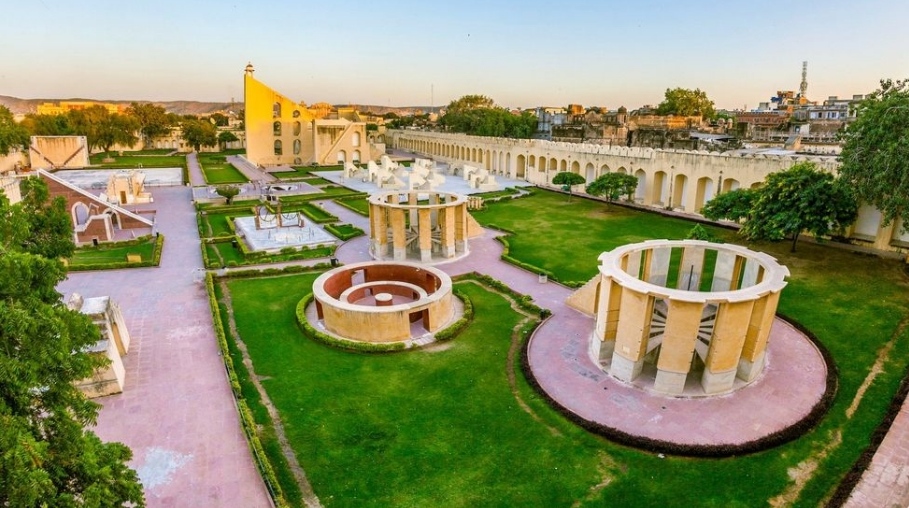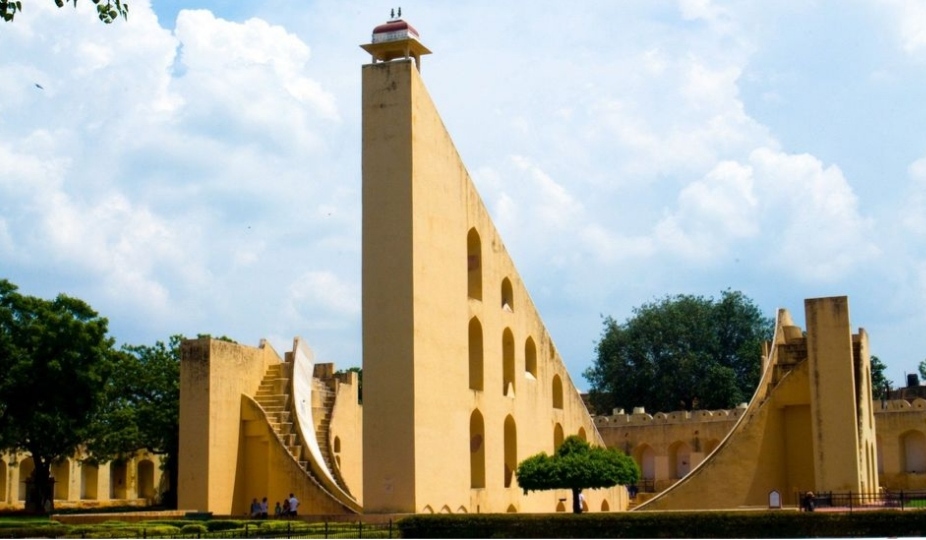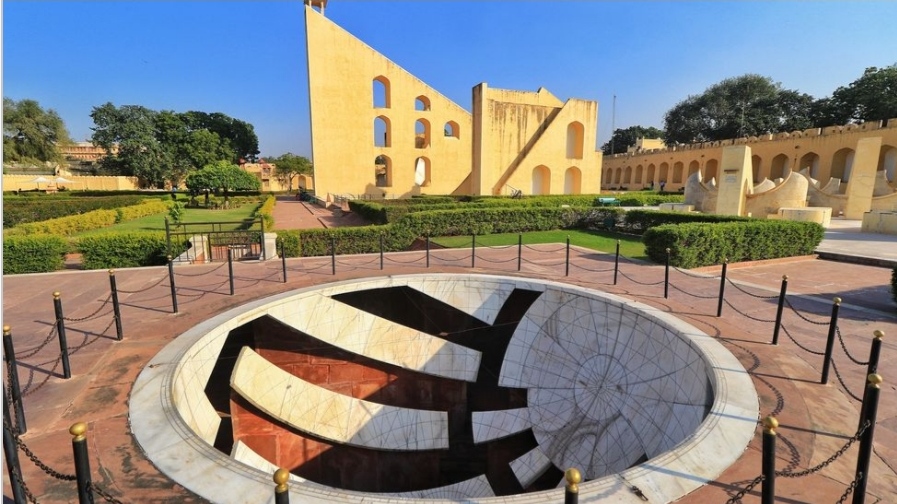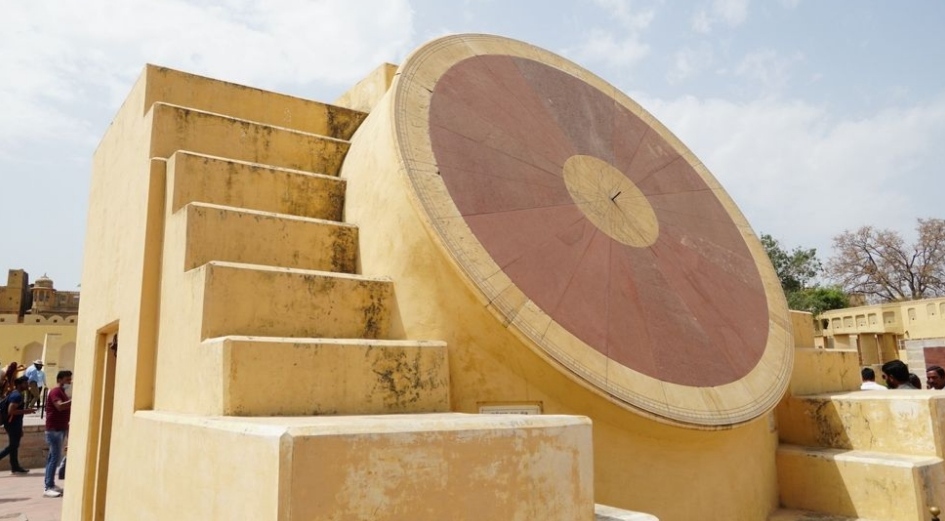India’s mysterious gateway to the stars

By
Shambhala Sarda
Created 300 years ago, Jaipur’s Jantar Mantar is an outdoor complex filled with gargantuan astronomy tools designed to be used by the naked eye – and they’re still accurate.
It was a week after the spring equinox, on a cloudless and hot afternoon. Perhaps a wrong time to venture out for sightseeing in Rajasthan’s desert capital of Jaipur, but a perfect one to measure time with shadows cast by the sun. I strode through the frenzy of the Johri bazaar, the city’s main market – its coral walls, delicate lattices and Mughal arches – sweeping by as I headed towards the Jantar Mantar, India’s mysterious gateway to the stars.
At first glance, this open-air complex filled with strange triangular walls and stairways to nowhere seems out of place: it’s neither ornate like the City Palace that surrounds it nor intricate like the revered Govind Dev Ji Temple and Hawa Mahal nearby.
The site – a 300-year-old collection of 20 scientific sculptures called yantra that can measure the positions of stars and planets, and precisely tell the time – had bemused me since my childhood here in Jaipur, when the structures seemed like giant versions of the delicate tools I kept in my school geometry kit. But years later, as a professional architect, I could better comprehend their use. They are ingenious architectural solutions to understanding the mechanics of astronomy, as well as key tools for traditional Hindu astrologers to craft birth charts and forecast auspicious dates.
In 1727, when the region’s king, Sawai Jai Singh, conceived Jaipur as his capital and as the country’s first planned city, he wanted to design it based on the principles of Vastu Shastra, which draw on nature, astronomy and astrology to inform architecture and placement. He realised that to perfectly align Jaipur with the stars, aid in astrological practices and predict key weather events for crops, he would need instruments that were accurate and accessible.

The Samrat Yantra is an enormous sundial: a 27m-high triangular wall with two semi-circular ramps that radiate like wings from its sides (Credit: MarcelloGoggio/Getty Images)
However, after sending research teams across Central Asia and Europe to collect data based on the knowledge of Islamic and European scientists, Sawai Jai Singh found discrepancies among the readings of the brass instruments that were widely used at the time. To increase accuracy, he scaled up the size of the tools, stabilised them by reducing moving parts and made them resistant to wear and weather by fashioning them out of marble and local stone. Then he used these innovations to build five outdoor observatories in the Indian cities of Jaipur, Delhi, Ujjain, Varanasi and Mathura.
Four Jantar Mantar survive (Mathura’s was demolished), but the one in Jaipur, completed in 1734, is the biggest and most comprehensive. Today, it is a Unesco World Heritage site, not only because it’s the best-preserved observatory of its kind in India, but as the Unesco inscription explains, it represents innovations in architecture, astronomy, and cosmology, as well as learnings and traditions from Western, Middle Eastern, Asian, and African cultures.
In Sanskrit, jantar means instruments, and mantar denotes calculator, so each of the yantra in the complex has a mathematical purpose: some are sundials to tell the local time and pinpoint the sun’s position on the hemisphere; while others measure constellation and planetary movements to detect zodiac signs and guide forecasts.
The most prominent of all is an enormous equinoctial sundial called the Samrat Yantra, a 27m-high triangular wall with two thin, semi-circular ramps that radiate like wings from its sides. Standing beneath it, my guide pointed out the shadow on one of the ramps as it moved precisely 1mm every second and indicated the local time within an accuracy of two seconds.

The Jai Prakash Yantra measures the sun’s trajectory through the Indian Vedic zodiac signs to determine horoscopes (Credit: NurPhoto/Getty Images)
Another yantra, the Jai Prakash, measures the sun’s trajectory through the Indian Vedic zodiac signs to determine horoscopes. Its bowl-shaped structure, which is set into the ground, is like an inverted map of the sky, and a tiny metal plate suspended on a crosswire casts a shadow to show the position of a chosen star or planet.
“I used these instruments in my two years of the master’s programme quite often,” said Neha Sharma, who now holds a doctorate in Jyotish Shastra (Vedic astrology) from Rajasthan University. “Learning to read and calculate from these instruments is still a compulsory part of the curriculum for anyone who wants to pursue astrology as a career option.”
However, most of the modern scientific world viewed the Jantar Mantar observatories as a novelty until renowned Indian astrophysicist Dr Nandivada Rathnasree argued that the structures were still pertinent. In her role as the director of Delhi’s Nehru Planetarium (from 1999 until her death in 2021), she encouraged students to gain hands-on experience of positional astronomy at the various Jantar Mantar, and pushed for their academic and international recognition.

The Nadivalaya Yantra can calculate the local time and position of the sun in either of the hemispheres (Credit: Shalbha Sarda)
“It was Nandivada Rathnasree who got Jantar Mantar into the limelight in the scientific fraternity,” said Rima Hooja, an archaeologist and consultant director of the Maharaja Sawai Man Singh II Museum in the City Palace. “She also played a pivotal role in getting Jantar Mantar Jaipur recognised as a Unesco World Heritage site.”
The Jantar Manatar continues to garner fame, not only for its architectural ingenuity but for its classical style. “Superficially, Jantar Mantar may not look like an indigenous architecture,” said Kavita Jain, a conservation architect based in Jaipur. “But when you look at it closely, the high-rise sundial is made stable by creating voids in the form of arches. The Hindu canopies crowning the instruments, the marble and the stone used in the construction are all reminiscent of local architectural values.”
Today, students, scientists and tourists from many disciplines and cultures across the world understand that Jaipur’s Jantar Mantar is much more than a historical monument. Situated at the core of a thriving ancient city of forts and palaces, its monolithic structures continue to mirror the cosmos and create a lasting legacy.
Source : BBC Travels




